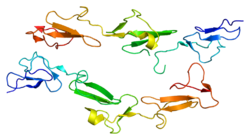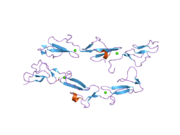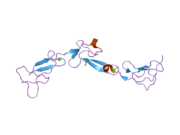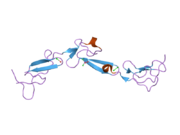
Versican is a large extracellular matrix proteoglycan that is present in a variety of human tissues. It is encoded by the VCAN gene.
The EGF module-containing Mucin-like hormone Receptors (EMRs) are closely related subgroup of G protein-coupled receptors (GPCRs). These receptors have a unique hybrid structure in which an extracellular epidermal growth factor (EGF)-like domain is fused to a GPCR domain through a mucin-like stalk. There are four variants of EMR labeled 1–4, each encoded by a separate gene. These receptors are predominantly expressed in cells of the immune system and bind ligands such as CD55.

EGF-like module-containing mucin-like hormone receptor-like 1 also known as F4/80 is a protein encoded by the ADGRE1 gene. EMR1 is a member of the adhesion GPCR family. Adhesion GPCRs are characterized by an extended extracellular region often possessing N-terminal protein modules that is linked to a TM7 region via a domain known as the GPCR-Autoproteolysis INducing (GAIN) domain.

EGF-like module-containing mucin-like hormone receptor-like 3 is a protein encoded by the ADGRE3 gene. EMR3 is a member of the adhesion GPCR family. Adhesion GPCRs are characterized by an extended extracellular region often possessing N-terminal protein modules that is linked to a TM7 region via a domain known as the GPCR-Autoproteolysis INducing (GAIN) domain.

Cluster of differentiation 97 is a protein also known as BL-Ac[F2] encoded by the ADGRE5 gene. CD97 is a member of the adhesion G protein-coupled receptor (GPCR) family. Adhesion GPCRs are characterized by an extended extracellular region often possessing N-terminal protein modules that is linked to a TM7 region via a domain known as the GPCR-Autoproteolysis INducing (GAIN) domain.

G protein-coupled receptor 64 also known as HE6 is a protein encoded by the ADGRG2 gene. GPR64 is a member of the adhesion GPCR family. Adhesion GPCRs are characterized by an extended extracellular region often possessing N-terminal protein modules that is linked to a TM7 region via a domain known as the GPCR-Autoproteolysis INducing (GAIN) domain.

Latrophilin 1 is a protein that in humans is encoded by the ADGRL1 gene. It is a member of the adhesion-GPCR family of receptors. Family members are characterized by an extended extracellular region with a variable number of protein domains coupled to a TM7 domain via a domain known as the GPCR-Autoproteolysis INducing (GAIN) domain.

Probable G-protein coupled receptor 124 is a protein that in humans is encoded by the GPR124 gene. It is a member of the adhesion-GPCR family of receptors. Family members are characterized by an extended extracellular region with a variable number of protein domains coupled to a TM7 domain via a domain known as the GPCR-Autoproteolysis INducing (GAIN) domain.

G protein-coupled receptor 126 also known as VIGR and DREG is a protein encoded by the ADGRG6 gene. GPR126 is a member of the adhesion GPCR family. Adhesion GPCRs are characterized by an extended extracellular region often possessing N-terminal protein modules that is linked to a TM7 region via a domain known as the GPCR-Autoproteolysis INducing (GAIN) domain.

Probable G-protein coupled receptor 123 is a protein that in humans is encoded by the GPR123 gene. It is a member of the adhesion-GPCR family of receptors. Family members are normally characterized by an extended extracellular region with a variable number of protein domains coupled to a TM7 domain via a domain known as the GPCR-Autoproteolysis INducing (GAIN) domain.

G protein-coupled receptor 128 is a protein encoded by the ADGRG7 gene. GPR128 is a member of the adhesion GPCR family. Adhesion GPCRs are characterized by an extended extracellular region often possessing N-terminal protein modules that is linked to a TM7 region via a domain known as the GPCR-Autoproteolysis INducing (GAIN) domain.

G protein-coupled receptor 112 is a protein encoded by the ADGRG4 gene. GPR112 is a member of the adhesion GPCR family. Adhesion GPCRs are characterized by an extended extracellular region often possessing N-terminal protein modules that is linked to a TM7 region via a domain known as the GPCR-Autoproteolysis INducing (GAIN) domain.

G protein-coupled receptor 114 is a protein encoded by the ADGRG5 gene. GPR114 is a member of the adhesion GPCR family. Adhesion GPCRs are characterized by an extended extracellular region often possessing N-terminal protein modules that is linked to a TM7 region via a domain known as the GPCR-Autoproteolysis INducing (GAIN) domain.

G-protein coupled receptor 97 also known as adhesion G protein-coupled receptor G3 (ADGRG3) is a protein that in humans is encoded by the ADGRG3 gene. GPR97 is a member of the adhesion GPCR family. Adhesion GPCRs are characterized by an extended extracellular region often possessing N-terminal protein modules that is linked to a TM7 region via a domain known as the GPCR-Autoproteolysis INducing (GAIN) domain.

Probable G-protein coupled receptor 110 is a protein that in humans is encoded by the GPR110 gene. This gene encodes a member of the adhesion-GPCR receptor family. Family members are characterized by an extended extracellular region with a variable number of N-terminal protein modules coupled to a TM7 region via a domain known as the GPCR-Autoproteolysis INducing (GAIN) domain.

Probable G-protein coupled receptor 133 is a protein that in humans is encoded by the GPR133 gene.

Probable G-protein coupled receptor 144 is a protein that in humans is encoded by the GPR144 gene. This gene encodes a member of the adhesion-GPCR family of receptors. Family members are characterised by an extended extracellular region with a variable number of protein domains coupled to a TM7 domain via a domain known as the GPCR-Autoproteolysis INducing (GAIN) domain.

G protein-coupled receptor 56 also known as TM7XN1 is a protein encoded by the ADGRG1 gene. GPR56 is a member of the adhesion GPCR family. Adhesion GPCRs are characterized by an extended extracellular region often possessing N-terminal protein modules that is linked to a TM7 region via a domain known as the GPCR-Autoproteolysis INducing (GAIN) domain.

Adhesion G protein-coupled receptors are a class of 33 human protein receptors with a broad distribution in embryonic and larval cells, cells of the reproductive tract, neurons, leukocytes, and a variety of tumours. Adhesion GPCRs are found throughout metazoans and are also found in single-celled colony forming choanoflagellates such as Monosiga brevicollis and unicellular organisms such as Filasterea. The defining feature of adhesion GPCRs that distinguishes them from other GPCRs is their hybrid molecular structure. The extracellular region of adhesion GPCRs can be exceptionally long and contain a variety of structural domains that are known for the ability to facilitate cell and matrix interactions. Their extracellular region contains the membrane proximal GAIN domain. Crystallographic and experimental data has shown this structurally conserved domain to mediate autocatalytic processing at a GPCR-proteolytic site (GPS) proximal to the first transmembrane helix. Autocatalytic processing gives rise to an extracellular (α) and a membrane-spanning (β) subunit, which are associated non-covalently, resulting in expression of a heterodimeric receptor at the cell surface. Ligand profiles and in vitro studies have indicated a role for adhesion GPCRs in cell adhesion and migration. Work utilizing genetic models confined this concept by demonstrating that the primary function of adhesion GPCRs may relate to the proper positioning of cells in a variety of organ systems. Moreover, growing evidence implies a role of adhesion GPCRs in tumour cell metastasis. Formal G protein-coupled signalling has been demonstrated for a number for adhesion GPCRs, however, the orphan receptor status of many of the receptors still hampers full characterisation of potential signal transduction pathways. In 2011, the adhesion GPCR consortium was established to facilitate research of the physiological and pathological functions of adhesion GPCRs.

The GAIN domain is a protein domain found in a number of cell surface receptors, including adhesion-GPCRs and polycystic kidney disease proteins PKD1 and PKD2. The domain is involved in the self-cleavage of these transmembrane receptors, and has been shown to be crucial for their function. Point mutations within the GAIN domain of PKD1 and GPR56 are known to cause polycystic kidney disease and polymicrogyria, respectively.





















